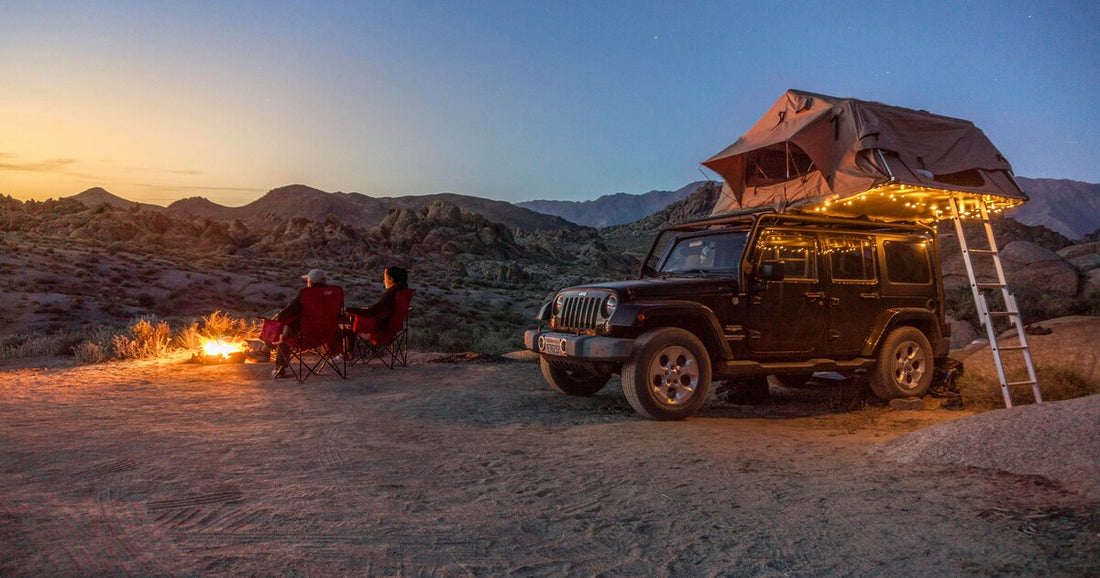Beyond getting your roof top tent ("RTT") on the roof of your vehicle, there are a few different ways that you can both position and orient your tent. They all have various pros and cons. At end of the day, it's about setting it up the way you like as part of your camping setup.
Which way should my tent open? Passenger Side, Driver Side, or Off The Back?
A common debate with no right answer. But there are a few factors what will help most RTT owners decide:
1. Does the trunk/rear door/tailgate of your vehicle open upwards? Or does it swing to the side or down? If it opens upwards, it's best to position your RTT opening to either the passenger or driver side. This allows you to continue to fully open and have access to the back of your car - where everything else is usually being stored. Just avoid the frustration (and potential paint damage) of your tent base / ladder constantly bumping into your trunk.

Especially for vehicles with rear hatch trims (like the Toyota 4Runner), the trim will also prevent you from being able to open the trunk - positioning your tent to open side ways is, in this case, the best way!

2. Do you expect to ever camp on the side of the road or a trail?
This is an important safety question, if you're always camping in provincial parks or on Crown Land in specific camp spots, then you are free to open the tent in either direction. However if you intend to do a lot of traveling or off-roading and camping just off the trail it is important to think about the safety aspect.
Some times in long overlanding trips you will have to stop on the side of a small road or a trail to sleep for the night as there are simply no suitable spots away from the road. This means that at any point, vehicles may pass by you.
In this case it is wise to have your tent open to the passenger side. Doing so helps ensure that you won't accidentally step out into the path of a passing vehicle while getting out for a nature call at 3am, and you are basically placing your large, metal vehicle between you and the road. The ladder that protrudes away from the tent, would also not accidentally be in anyone's way.

3. A sideways install allows you access to your vehicle from the annex.
If you're setting up an annex, under your tent and would still like to maintain easy - covered - access to your vehicle via a door or window, then a tent open to the side is best. This way your annex will be roughly around your rear door and grant access directly to the vehicle, while still being protected from the weather by the tent and annex.

4. Awnings, how many do you have?
Some folks like to have a full base setup with multiple awnings. If you're setting up 2 awnings on either side of your vehicle, then it may be better to open your tent to the rear. This way you now effectively have "3" awnings, providing more overhead coverage from the elements. Depending on the length of your vehicle and your awnings, you may be able to setup both to open on the same side, in which case you would have a nice long continuous space.

Should I put the tent toward the front, centre or back of my roof?
While the positioning of your tent will influence the aerodynamics of your vehicle and weight distribution, it is mostly based on personal preference.
-
Front:
- Potentially room to store other items on the back of your rack
- The RTT can act as a windbreak for items - especially for hardshell tents that are more aerodynamic - this means less wind drag
- Helps balance your vehicle's weight distribution if you plan on loading the back with cargo / supplies
- Will cover a sunroof if you have one
- If you have an annex, make sure the opening half of the tent clears the edge of your vehicle
-
Middle:
- Balanced means no uneven strain on your suspension and tires
- Might be trickier to store other items on the smaller spaces in front and behind your RTT on the roof rack
- If you have an annex, make sure the opening half of the tent clears the edge of your vehicle
-
Back
- It may make your vehicle relatively less aerodynamic
- Extra weight will place extra strain on the rear drive train
- Opens up front portion of roof as storage area
- Keeps your sunroof clear
- Might get in way of tailgate opening fully
For Trucks: Should I put it on a rack, above the cab or in the bed?



Installing a tent on top of a rack, truck cap or above the cab can maximize the storage space you have available for other stuff and allow you to continue using your truck bed. However, installing it higher up will result in greater wind resistance and lower fuel efficiency. Also, for most underground parking lots and home garages, you'll frequently exceed the maximum height restrictions.
We've also seen folks install tents just above the bed. This allows them to minimize any additional wind resistance by keeping it below the cab height. However, it can make it challenging to access items at the very back of your truck bed. Many however solve this with dedicated slide out cabinets or other setups to maximize their truck bed storage.
You could also leave the tent within the truck bed. That of course only works with smaller tents like the Thule Tepui Ayer, assuming they fit in the bed. You would also have to open them towards the back. This solution is not common as you lose all other use of your truck bed.
As you can see, there are some design considerations that would mandate how you cannot open a tent and thus push you towards another direction. But the majority of the decision is really up to personal preference and there is no wrong answer.
Consider all that we have shared above, to make a calculated decision based on what works for you!

As always, if you have any questions or want a second opinion, feel free to reach out to us through our Contact Us form, via email at info@redbearoutdoors.ca or call / text us at (647) 94

